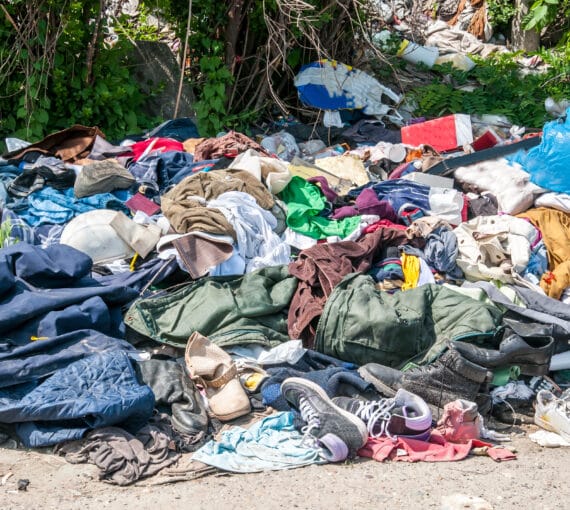
Online shopping is convenient and has some environmental benefits. But the planet is paying a hefty price for overconsumption, packaging, transportation, returns and disposability. (Photo: Karolina Grabowska via Pexels)
Online shopping has revolutionized buying habits. E-commerce connects customers and sellers worldwide. You can get anything from clothing to groceries and furniture at the click of a button, delivered right to your door. Online shopping’s convenience and accessibility can’t be denied. But it comes at a hefty environmental price.
The rise and dominance of online shopping
Digitalization and advancement of innovative technologies have transformed the way people shop. They’ve had a huge influence on consumer behaviour and global culture.
In 1995, the founding of Amazon and eBay (formerly AuctionWeb) sparked the first online marketplace boom. Online shopping expanded in the early 2000s when big retailers such as Walmart came on board. Soon sellers (brick-and-mortar and online-only) invested heavily in e-commerce platforms. Online shopping continued to rapidly increase in the early 2010s with the rising popularity of smartphones. This drove more social media and influencer marketing, making it even easier for people to find and buy products fast.
The mandated lockdowns, social distancing protocols and safety concerns of the COVID-19 pandemic sped up the shift to online shopping. While brick-and-mortar retail sales dropped to record lows in Canada, e-commerce sales increased by 67.9 per cent from February 2020 to July 2020. Meanwhile, the world’s leading online marketplace, Amazon, broke records. It raked in $386 billion in revenue in 2020, an 86 per cent net profit increase.
Economic impact of online shopping in Canada
Canada has nearly 27 million digital buyers. They’re responsible for nearly $110 billion in online retail sales. Forecasts are that digital buyers in Canada will increase and hit 31.8 million by 2027 — nearly the entire population (38 million in 2023). That’s a lot of purchasing power. If used wisely, it can make a huge difference!
Online shopping may become almost unavoidable, but how we do it can help reduce its environmental impact.
Environmental impacts of online shopping
Online shopping has revolutionized consumer habits. It’s also influenced broader societal trends, including how people understand convenience, consumerism and the global economy. It continues to shape expectations, behaviours and interactions with commerce.
Overconsumption, packaging, transportation, returns and disposability are all part of the systems and culture of online shopping with environmental impacts. Can we find a balance between convenience and sustainability?
“When people buy less stuff, you get immediate drops in emissions, resource consumption and pollution, unlike anything we’ve achieved with green technology.” J.B. MacKinnon
Amazon: delivering climate change
Amazon’s formula of price, speed and convenience has dominated the global e-commerce marketplace. But the e-retailer’s success has exploited workers and the planet while driving up carbon emissions that cause climate disruption.
In 2021, Amazon generated 71.54 billion metric kilograms of carbon dioxide. That’s the amount 180 gas-fired power plants might pump out in a year — an 18 per cent increase from 2020. Its “Climate Pledge” allows the company to get away with misleading carbon accounting and fails to include emissions from manufacturing many products it sells.
The online giant was also investigated for destroying millions of unused or returned products. Whatever energy, water and materials used to produce and transport all that stuff ends up as waste.
The dark side of Black Friday and Cyber Monday
Every year, millions wait for annual online shopping events like Black Friday and Cyber Monday (and Boxing Day in Canada).
Black Friday and Cyber Monday follow American Thanksgiving. Two of the busiest, most lucrative online shopping days of the year, they kick off the swell of winter holiday season e-commerce sales. Retailers offer alluring deals, limited-time discounts and promises of swift deliveries.
“Time-bound” purchase incentives and the psychology of scarcity can perpetuate a false sense of urgency. That compels people to shop fast, without thinking through decisions. A University of Leeds study found that up to 80 per cent of Black Friday purchases end up in landfills, sometimes after just one use.

From runway to landfill
Fast fashion may glitter and gleam, but its environmental footprint is far from fabulous.
Online shopping: a sustainability conundrum
Online shopping can boast some environmental benefits. But it’s complicated…
MIT researchers investigated consumers’ carbon emissions. They compared online shopping to brick-and-mortar stores. They simulated hundreds of thousands of scenarios and found that online shopping is a better option 75 per cent of the time. Simply put, one van delivering 100 packages is more efficient than 100 people driving to the store.
But their study focused on the final part of the supply chain, the “last mile” — the very last step of the delivery process. Say you’re in Canada and you order a linen blanket from an e-retailer in India. That package must travel from India to Canada, usually by air or sea freight to a Canadian port. It’s then sorted and either sent to another distribution centre or put onto a vehicle for home delivery. The second that blanket lands in the delivery vehicle, it’s on its “last mile.” This ignores the journey from its origin, which could be far, with immense emissions. China generates almost 50 per cent of the world’s e-commerce transactions, so most online purchases are travelling great distances.
To reap environmental benefits from online shopping, you must be diligent. Here are six pitfalls to avoid:
Six ways to lower your online shopping environmental impact
1. Replace, not supplement
Using online shopping to supplement your in-person routine adds extra vehicles to the road.
Say you drive to the supermarket to buy your week’s groceries. A preferred product isn’t available. Rather than choosing an in-store alternative, you buy it online. That’s two vehicle trips: one to the store by you and one for the online delivery to you.
Only use online shopping to replace not supplement in-store shopping. This reaps the environmental benefits of e-commerce while reducing unnecessary transportation emissions.
2. Transportation and delivery
From distribution centres and warehouses to doorsteps, transportation of online shopping purchases contributes to carbon emissions. These climb if a package comes from overseas and uses more than one mode of transportation.
To meet increasing demand, delivery companies are growing their fleets. It’s estimated that the number of delivery vehicles will increase by 36 per cent by 2030 — 7.6 million (mostly gas-powered) vehicles. This will increase carbon emissions by six billion kilograms and (because of more traffic congestion) lengthen commute times 21 per cent.
The faster you want your item delivered, the higher the environmental price. Ensuring fast delivery often uses airplanes. Transporting goods by air generates approximately 50 times more carbon emissions per kilometre than shipping by sea.
An MIT study found that in-store shopping has two times the carbon footprint when compared to online shopping. But this is only true when the shopper does not opt for fast delivery. When delivery companies are under a one-or two-day delivery window, they can’t wait for all products heading to the same destination to arrive before shipping them out. This forces them to send out trucks and planes not filled to capacity, increasing the carbon footprint of each item delivered.
Solutions:
- Shop ahead. Be patient. Choose slower delivery methods whenever possible. This helps retailers maximize efficiency by consolidating orders.
- Avoid failed delivery and extra trips. If you’re unsure you’ll be home at delivery time, have your package sent to the nearest post office.
- Group purchases. Order many things at the same time so everything gets boxed together. If ordering from an online marketplace that hosts a variety of sellers, package items together.
- Support companies that offset shipping emissions by investing in environmental or carbon-neutral projects.
- Reduce the distance items travel. Favour local businesses and locally sourced products.
- Support sustainable last mile delivery solutions, such as bike couriers and electric vans.
- Reduce placing more frequent orders. Buy products you can only get from online retailers in bulk.
3. Packaging
Cardboard, plastic bubble wrap and Styrofoam fillers are common single-use packaging materials. Sellers often use them in excess to reduce risk of damage during transportation and delivery. Multi-material multilayer plastic packaging has quickly become popular for its durability. But it’s difficult to recycle. A 2022 study said there will be no mainstream solutions for recycling multi-material multilayer plastic packaging in the next five to 10 years.
According to the Environmental Protection Agency, containers and packaging accounted for more than 80 billion kilograms of municipal solid waste in the U.S. in 2018, with e-commerce being a significant contributor. The Ellen MacArthur Foundation conducted a study that determined that of the 86 billion kilograms of plastic packaging produced globally each year, not even 14 per cent is recycled.
Solutions:
- Support companies that use minimal packaging and/or use eco-friendly packaging materials.
- Reuse, reclaim or recycle packaging whenever possible.

What kind of plastic can be recycled?
Plastic is everywhere. It’s hard to know what you can reuse, what you can recycle and what you can do to reduce your plastic consumption.
4. Returns and exchanges
A study by Deloitte found that shopping online leads to five times more returned products. About 40 per cent of online purchases are returned, compared to only seven per cent of products bought in-store. Returning products increases online shopping’s environmental impact.
Returning items involves shipping them back to the retailer’s distribution centre or store. This generates more transportation carbon emissions and packaging waste. To make matters worse, retailers can’t always resell returned items not in their original condition. With their packaging, this leads to more waste in landfills.
Solutions:
- Reduce returns arising from inaccurate expectations. Read all product information, including size, material composition and customer reviews.
- If an online purchase doesn’t suit you, re-sell it locally.
- If the product is defective or broken, ask the retailer if it has a local distribution centre you can take it to or an authorized local repair service that can fix it. Or seek repairs locally.
- Support sellers with recycling, reuse or take-back programs. (Recycle e-waste appropriately.)
5. Overconsumption
Overconsumption is a primary driver of the environmental crisis. Online shopping’s extensive product variety, expert marketing campaigns, speed of delivery and sales promotions encourage impulse buying binges. Constantly changing trends create feelings of insatiability that compel people to buy more. Anticipation of a reward (i.e., package delivery) releases dopamine to the brain. One study showed that 76 per cent of Americans get more excited awaiting delivery of online purchases than from in-store immediate gratification. Both can lead to shopping addiction.
Solutions:
- Think before you click. Be mindful when shopping.
- Create shopping lists. Do thorough product research before buying.
- Lower your consumption in all areas of your life.
- Seek healthy dopamine alternatives (e.g., meditation, music, exercise, connecting with nature, etc.).

The consumerist, fossil fuel era must end!
We’ve been deceived into thinking that buying more stuff and driving everywhere is the way to happiness. It’s not. We need to get back to basics and learn to respect the natural forces on which our survival depends.
6. Disposability
Online shopping has worsened the cycle of buying, replacing and discarding. This contributes to a linear “take, make, waste” model that depletes land and water, creates waste, degrades nature, ignores justice and fails to ensure equity. We devour the planet’s gifts 1.7 times faster than it can regenerate. Play your part in dismantling single-use and disposability culture.
Solutions:
- Buy with longevity in mind. Choose products built to last. If unsure, read reviews.
- Find eco-friendly alternatives to single-use products you use regularly (e.g., floss, face masks, straws, etc.)
- Support brands that promote durability and repairability. If a component breaks, buy a replacement for that piece instead of a whole new product.
- Go zero waste and give up single-use plastics.



